The Peace Corps in the Time of Trump, Part One
On this last day of 2016, I thought I might try and chart the impulses in America that brought about the creation of the Peace Corps–something positive to think about as we wait for 2017–and before all of “our” story is lost in the fog of history. 
Most of the early history of the Peace Corps, as we know, lives only as oral history. Still, there are a few key books that spell out in some detail the foundations of the agency. Two important books are The Story of the Peace Corps by George Sullivan, and that has an introduction by Sargent Shriver. It was published by Fleet Publishing in 1964. A second one is Peace Corps: Who, How and Where by Charles E. Wingenbach, with a foreword by Hubert H. Humphrey, and published by John Day Company in 1963. A revised edition by Wingenback was later published by McGraw-Hill in 1965. Both books, from different perspectives, cast light on the nascent idea of the peace corps concept. A third book, written by Elizabeth Cobbs Hoffman entitled All You Need Is Love: The Peace Corps and the Spirit of the 1960s, published by Harvard University Press in 1998, relates the creating of the Peace Corps in broader terms, showing how the ‘idea of a peace corps’ was alive elsewhere in the western world.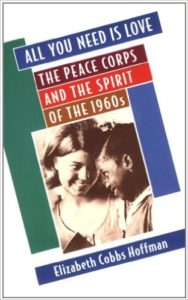
But back to America! And back to Wednesday, November 2, 1960, with the Kennedy/Nixon presidential election just two weeks away. Let’s begin at the end and work backward to the beginning.
Richard Nixon was campaigning in New York, trying to capture that state’s 45 electoral votes. He had, for the first time, President Eisenhower by his side as they campaigned together through New York City that fatefully day.
Kennedy was across the country in California working long days and nights and appearing in front of huge and frenzied crowds.
On the morning of November 2, 1960, JFK had a breakfast rally at the Beverly Hilton Hotel in Los Angeles, speaking to 1,200 women. Next, he flew to San Diego for another appearance, then headed north to the Bay area of San Francisco. He spoke at a rally in San Jose, and to thousands more at the Oakland’s deFremery Park.
At every stop, the newspapers wrote, he was hailed by throngs of “screamers, runners, exhorters, and jumpers.” In San Jose, for example, three police officers were injured trying to control the crush of the crowd.
Early on the evening of the 2nd, at the San Francisco’s Sheraton Palace Hotel, 1,500 Democrats paid $100-a-plate for dinner so they could hear Kennedy tell them how Nixon had begged Eisenhower to campaign with him at least once before the election. The candidate main speech of the day, and perhaps the main speech of the campaign, was that evening at the Cow Palace, San Francisco’s anomalously-named cattle exhibition auditorium.
Two hours before Kennedy was to arrive at the Cow Palace, 25,000 people had jammed into the hall, filling it to capacity. Another 5,000 surged through the corridors outside the auditorium chanting, “We want in! We want in!” Inside the auditorium, the 25,000 in their seats responded with, “We want Kennedy! We want Kennedy!”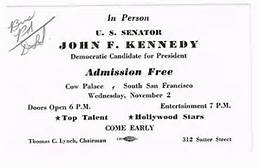
Then just before JFK arrived, the outsiders broke through a door from the corridors and spilled into the arena. There were no seats; there was no room. They stood in the aisles and when Kennedy arrived there was a near riot. It took fifteen minutes to silence the tumultuous cheering.
In the sudden silence, Kennedy stepped to the podium and gathered their attention for his lasted major speech before the election. It was the speech where Kennedy would outline his ‘peace corps,’ using that term for the first time.
The idea of a peace corps-type program had been, as George Sullivan writes in his book, “adrift in political circles for almost a decade” but when Kennedy stepped to the microphones and announced that with his new administration there would be a ‘Peace Corps,’ a pool of “talented young men willing to serve….in the under-developed world” it was as if the idea was being expressed for the first time, and in full maturation.
Kennedy called for “Ambassadors of Peace,” for skilled Americans who “could work, building goodwill, building the peace.” That night, in the raging melee of the Cow Palace of San Francisco, the Peace Corps was born.
As Thurston Clarke (Tunisia 1968) points out in his book Ask Not: The Inauguration of John F. Kennedy and The Speech That Changed America, and Chris Matthews (Swaziland 1968-70) alludes to in his book on Kennedy, Elusive Hero, most of JFK’s great speeches evolved over time with ideas and paragraphs of prose being sharpened and changed and improved from one speech to the next during the campaign of 1960.
The idea for the Cow Palace speech on the Peace Corps has such a gestation period. To begin with, Kennedy was well aware of a ‘youth crop’ talk in the halls of Congress.
In 1958 the novel The Ugly American by William J. Lederer and Eugene Burdick was published. As a Senator, Kennedy had sent a copy to every member of Congress. The bitter message of this novel was that Americans diplomats were, by and large, neither competent nor effective. The implication of the plot was that the more the United States relied on such ‘diplomats’, the more the U.S.’s influence would wane. The novel came out in July 1958. It was a Book-of-the-Month selection in October; by November it had gone through twenty printings. Later paperback editions its cover proclaimed that “President Kennedy’s Peace Corps is the answer to the problem raised in this book.”
The ‘idea’ of a ‘peace corps’ was, in the words of Kennedy’s Press Secretary Pierre Salinger, “gradually building” even before Kennedy alluded to it in his pre-dawn address in late October to the students at the University of Michigan. While the Peace Corps was the U.S. government’s “quintessential social reform institution” of the decade, Cobbs Hoffman in her book points to two other themes that were in the air: a rebellion against mass society and “the widely popular existentialist emphasis on individual choice.” These were coupled, in the American case, “with a desire to recapture the rigors of the old frontier,” so much so that Kennedy described his administration as the New Frontier. These impulses set the stage for the attitude of Peace Corps Volunteers at the dawn of the decade.
Kennedy’s chief speech writers at the time were Archibald Cox, who would become Solicitor General in the new administration, and Ted Sorenson, whose daughter, years later, would become a PCV in Morocco.
The Cow Palace in San Francisco was seen by the Kennedy campaign team as an appropriate forum to make a formal endorsement of a new ‘youth corps.’ Some of Kennedy’s advisers felt it would be helpful in winning the votes of Stevensonian Democrats and liberal Republicans. There was also a rumor, proved untrue, that Nixon was planning to make an announcement of their endorsement of a Youth Corps.
Kennedy also knew, based on the reception he had received at the University of Michigan two weeks earlier, that the idea of a peace corps would be a popular issue with the people. And indeed it was. A Gallup poll had 71 percent of Americans backing the idea; 66 percent wanted their sons to join it. (No one, then, asked about the daughters.)
Kennedy’s Peace Corps speech at the Cow Palace had several new elements that had not been previously part of the concept. He opened the Peace Corps to women, and he softened the age requirement so older Americans could and would join. In his speech he also suggested that the Peace Corps service could be an “alternative to peacetime selective service.” That never happened, thought Nixon declared later in attaching the idea of the agency that the Peace Corps would “be a haven for draft dodgers.”
The Cow Palace Speech was the major news story the next day. It was front-paged in a thousand daily newspapers. George Sullivan writes in his book, “Thirty thousand Americans wrote to Kennedy in support of the idea. Pierre Salinger said no topic during the campaign received as much mail. In those letters, thousands more wrote that they were also volunteering to join.”
On college campuses throughout the country, study groups and clubs were organized to talk about the idea. While we will see that the ‘peace corps’ idea was not necessarily new, according to Dr. Samuel Hayes, an early Peace Corps adviser, Kennedy’s proposal had lifted the idea “to a much higher level and to a much broader scope.”
John F. Kennedy in 1960 had the courage and the vision to make the Peace Corps his administration’s national policy and that would make all the difference. But the question remains: who thought of a ‘Peace Corps’ in the first place?
The Peace Corps wasn’t Kennedy’s idea. It wasn’t a Democrat’s idea. It wasn’t even Shriver’s idea.
Writing In Foreign Affairs magazine about the creation of the Peace Corps, Shriver would quote Oscar Wilde comment that America really was discovered by a dozen people before Columbus, “but it was always successfully hushed up.” Shriver added, “I am tempted to feel that way about the Peace Corps; the idea of a national effort of this type had been proposed many times in past years.”
Beginning in 1809, churches in the United States started to send missionaries abroad. Besides preaching the gospel, missionaries also built hospitals and educated doctors and nurses. They helped farmers and they developed health and social welfare programs. They did much of what Peace Corps Volunteers would also do later in the history of America.
The missionaries weren’t the only ones going overseas to help others.
In 1850, British writers Thomas Carlyle and John Ruskin advocated “industrial regiment….to fight the bogs and wildernesses at home and abroad…” Ruskin even attempted to implement the idea by having Oxford dons and students build a road nearby, but it was a dismal flop.
In 1904 philosopher William James proposed to the Universal Peace Congress in Boston that draft-age young men be put to work building, not destroying. James called his project “the moral equivalent of war.” He had seen the veterans of the Spanish-American War who stayed behind in the Philippines in 1901 to teach and work in the barrios.
The men who ’stayed behind’ were called the “Thomasites” and named after the converted battle cruiser, “Thomas” that took these volunteers to the island.
A thousand teachers began their work in 1901. It lasted until 1933. Lacking government sanction or support, during the first 20 months, 27 of the volunteers died. But as George Sullivan writes, “in size and type, in philosophy and in motivation, it was in many ways similar to our present day Peace Corps teaching contingent in the archipelago.”
By 1919, the American Friends Service Committee, the Quakers, were sailing to the Balkans to work for two years to repair some of the chaos of World War I. They rebuilt farms, houses, schools, and established hospitals.
The truth is that after every major war, America has responded to help others. After the Spanish-American War, it was the “Thomasites.” After the World War I it was the work of the American Friends. After World War II private organizations like CARE were established; The Marshall Plan was activated, as well as, the government agency, UNRRA.
FDR inaugurated a three-pronged youth program during the Depression. The efforts were Civilian Conservation Corps (CCC), the Work Projects Administration (WPA), and the National Youth Administration (NYA). These programs, however, were temporary and limited in scope.
In 1948, in his inaugural address, President Truman announced the Point Four Program that was instituted to provide assistance for so-called “under-developed peoples.” That program became ICA (the International Cooperation Agency) and today is AID (Agency for International Development).
Also beginning in the early 1950s was the International Voluntary Services, the IVS, a coordinating agency for a group of 15 church denominations interested in private technical assistance programs. The IVS sent teams of young Americans to Laos, Viet Nam, and to Egypt, to train HCNs in agriculture, farm mechanics, animals husbandry, home economics, etc.
In early 1961, ICA had 9,000 technicians working 70 countries overseas. And when Kennedy announced the idea of the Peace Corps, he said the new agency would be “directed and paid by ICA-Point Four agencies.”
In the end, however, the Peace Corps was established within the State Department and given a separate status.
Elizabeth Cobbs Hoffman in the prolog of her book, All You Need Is Love points out that between 1958 and 1965 “nearly every industrialized nation started volunteer programs to spread the message of economic development and international goodwill.” While the U.S. wasn’t the first nation, they were the only nation to “incorporate volunteering into its foreign policy in an attempt to demonstrate one alternative to power politics.”
So by the year 1961–the year of the Peace Corps–there were already 26 private organizations carrying out volunteer service programs overseas. Still, against American policy and tradition of country-to-country relief and support, the Peace Corps was developing in another way.
And this is how it happened.
Some Peace Corps historians, including early Peace Corps staff, trace the idea for such an organization as ‘the Peace Corps’ back to the nineteenth-century American philosopher and psychologist William James, and his “moral equivalent of war” statement.
Bill Moyers, who was around the agency at the very beginning, was still saying in 2011 in an interview in Vanity Fair that he considered the Peace Corps his greatest professional achievement, adding, “We were making a statement to the world about America that is still valid half a century later. Remember, there is a moral alternative to war.”
William James wanted a “conscription of our youthful population” to form “an army against Nature.” Once conscripted, the young people would be assigned “to coal and iron mines, to freight trains, to fishing fleets in December, to dishwashing, etc.”
James’ idea wasn’t entirely altruistic. He felt that assigning young people into disciplined service would endow them with “healthier sympathies” and “soberer ideas.” He expressed, however, no desire for his ‘army’ to help indigent people of developing countries. Citing Williams James as the ‘true’ source of the agency is, in my opinion, a stretch.
The more likely source for the ‘idea’ of a peace corps might be with an obscure Republican from North Carolina, a wealthy German Jew industrialist, Heinz Rollman, who had fled Europe in 1939 and settled in Waynesville, North Carolina. In 1954, he wrote a book titled World Construction, which he mailed to government officials and opinion makers throughout the free world. His principal proposals were a 3-million-man “Peace Army” of draftees to work in underdeveloped nations and an increase to five million of foreign exchange students to the United States.
Twice Rollman ran for Congress from North Carolina and twice he lost. Twice he mailed his peace corps-type proposal to President Eisenhower and twice Eisenhower discarded the idea. Yet Eisenhower would use Rollman’s idea when he derided Kennedy’s ‘Peace Corps’ during the ’60s presidential campaign, saying that JFK’s program was just a warmed-over version of Heinz Rollman’s book, World Construction.
Rollman was never able to gain any popular support for his idea, no Congressional leaders supported him. He was unable to establish anything of concrete value beyond his book about what a “Peace army” might do in the developing world.
It was finally left up to a small town Congressman from the Midwest to make all the difference when it came to the launching the peace corps idea.
Congressman Henry S. Reuss of Wisconsin, representing the Milwaukee area, went to the Far East in the fall of 1957 on a foreign aid inspection tour. The U.S. government had recently paid thirty million dollars to build a highway through the Cambodian jungle that Reuss realized when he arrived in Cambodia was a road to nowhere.
One day he drove for miles along the new highway without spotting a single motorist. He spotted a solitary farmer trudging down the edge of the deserted road, his water buffalo in tow. The road, and the $30 million spent on it was all a waste of money.
But then, and by happenstance, in the same jungles of Cambodia, he came upon a village, and a new elementary school being built in the clearing by four young American school teachers. They told Reuss they had built the school with primitive tools and manual labor. They were volunteers going from village to village setting up elementary schools and teaching reading and writing. Reuss was awed by the respect, by the love, he said, that the host country nationals had for these young kids. The congressman realized how much more benefits the United States was able to gain from the work of American volunteer teachers than U.S. gained from spending millions to build a highway. He decided to do something about it.
Returning home, he gave a speech at Cornell University in April 1958, outlining the idea of a “Youth Corps” to the students who, according to Reuss, were swept up with the idea.
Reuss wasn’t the only American to be influenced by what he observed in Asia. Sargent Shriver, then working for his father-in-law in the Chicago Merchant Mart, and also the head of the board of education, was once a leader of the Experiment in International Living, and he had also just returned from a trip through Asia. He presented his own “Point-4 youth corps’ proposal to President Eisenhower as an extension of the Administration’s People-to-People program. Nothing came of it. Again, Eisenhower wasn’t interested.
Another American in Asia was also generating attention back home for his volunteer work. Dr. Tom Dooley was in Laos and he wrote two books about his experiences in Laos: The Edge of Tomorrow and They Burned the Mountains. He set up a non-profit foundation to raise funds for his work and when he died at the very young age in 1961 from malignant melanoma, Kennedy cited Dooley and his work as an example of what Peace Corps Volunteers would do overseas.
Meanwhile, in January of 1960 Congressman Reuss finally introduced legislation for the study of a “Youth Corps,” a bill co-sponsored in the Senate by Richard Neuberger of Oregon. But when the bill came up before the House Appropriations Committee, Chairman Otto Passman of Louisiana, a perennial foreign aid foe, struck out the $10,000 budget for the study. Reuss went to work behind the scenes and got the money restored by June 1960; it was finally approved in November 1960.
This bill only called for the study of the “feasibility of the Point Four Youth Corps idea. Passed as a rider to the Mutual Security Act the “Youth Corps” study became law in September 1960. The International Cooperation Agency (ICA) contracted the research study to the Colorado State University Research Foundation in Fort Collins. That study was done by the Director of the Foundation, Maurice L. Albertson, Andrew E. Rice and Pauline E. Birky. Their report was published by Public Affairs Press in 1961 and entitled, New Frontiers for American Youth: Perspective on the Peace Corps.
While this report was as comprehensive as any report could be, and served Shriver later in the development of the agency, it did not bring about the creation of a Peace Corps.
The idea for a ‘Peace Corps’ had yet to see the light of day in the dark hallways of Congress.
Another Midwesterner, Senator Hubert Humphrey of Minnesota, had observed the volunteer work being done by the American Friends Service Committee.
He, too, like Congressman Reuss, had given talks on college campuses in the late 1950s and received the same sort of strong, enthusiastic responses that Reuss experienced at Cornell University. Humphrey would say later that no one in ‘official government Washington’ would take him seriously, but he went ahead anyway and assigned a young member of his staff–a Stanford University foreign relations graduate named Peter Grothe–to research the idea for him, and what Grothe uncovered convinced Humphrey that the idea had merit.
Grothe spent six weeks interviewing private agency workers and digging through available material. In his final report, Grothe conservatively estimated that 10,000 volunteers could be sent into the field within four or five years. Humphrey cut that number to 5,000 in his final report. On June 16, 1960, Humphrey introduced legislation-drafted by Grothe-calling for the establishment of a “Peace Corps.” It was Grothe who first coined the term, Peace Corps. Coming as it was late in the congressional year, and an election year at that, nothing was expected to happen with the bill, though Humphrey was surprised by the lack of opposition in Congress to the legislation, and surprised, too, by, he said, the amount of mail received in favor of the idea. The “Peace Corps” idea dwarfed both the U-2 incident and the rise of Fidel Castro.
Humphrey did take flak from some quarters for introducing his legislation before the Colorado State University research report was completed. Also, some thought his “Peace Corps” would duplicate and/or conflict with the work already being done by the International Cooperation Agency (ICA).
In February, Kennedy faced his first question on the ‘corps’ while appearing on the New York television program, College News Conference. He admitted he didn’t know much about it, but when he returned to Washington, he instructed his staff to work on the idea, according to Charles E. Wingenbach in his book, The Peace Corps: Who, How, and Where.
During the long summer and fall of 1960–that presidential year–other ‘peace- corps-like program ideas’ were being proposed.
- Heinz Rollman in North Carolina was still busy lobbying for his idea;
- Bill Moyers, then the very young aide to Vice Presidential candidate Johnson, wrote two campaign speeches suggesting the Peace Corps idea.
- Chester Bowles, a foreign relations advisor to Kennedy, used the peace corps idea in his talks;
- Victor Reuther, at the UAW talked about a Peace Corps;
- General James Gavin also gave speeches in support of the idea.
In September, after Kennedy won the nomination, Peter Grothe took the Humphrey proposal to Archibald Cox, one of Kennedy’s speech writers. Kennedy’s team had already seen the idea’s potential, both as a new foreign policy breakthrough and as an election issue, and the Humphrey “Youth Peace Corps” was incorporated into Kennedy’s Talking Points. The term and new name “Peace Corps” now has visibility.
Then on October 14, 1960, at 2 a.m. in the morning on the campus of the University of Michigan candidate John F. Kennedy, speaking extemporaneous, challenged 10,000 plus students who had gathered in the predawn darkness on the campus lawns outside of the Student Union to make a difference in their own lives, to do something for their country.
He did not use the term ‘Peace Corps’ that morning in Michigan, but two weeks later, in the Cow Palace of San Francisco, Kennedy gave his last major speech before the 1960 election and used the name “Peace Corps.” It would prove to be the first major initiative as the new President of the United States. And it was in a speech to establish a “Peace Corps agency” in the federal government. We had arrived!
The rest, we can say, is history. And we can truthfully say and are honored to say, it is our history.
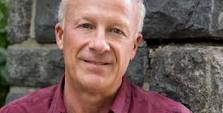
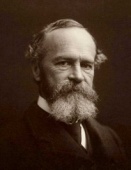

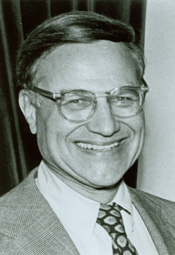
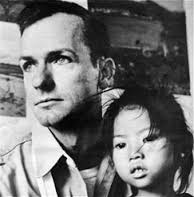

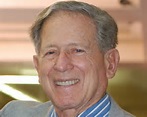
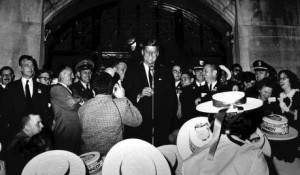
Great overview John! We need more projects like Alana deJoseph’s documentary on the Peace Corps “Towering Tasks” to convert that “oral History” to cinema or written history. We also need to develop other outlets for RPCV’s to share their stories–just the few RPCV’s who have reviewed my book’s manuscript, “Different Latitudes” have been inspired to share new stories about their experience in the field they’d almost forgotten–and in many cases although we tend to focus on the positive they went into some very “dark places” to remember injustice and violence they experienced–I’ll share some of this on my blog but will also be looking for other outlets to bring that collective experience and lessons learned to the public where it can help inform us during this period where international anything seems to hold a negative connotation and one of fear and mistrust.
Mark, Guatemala 1971-1973
Thanks John…brought back memories, hopes, and a future of a Peace Corps celebrating the first 100 years! My brother Ron (Peru 1963-1965), and I heard the Cow Palace speech on the Armed Forces Network while we were traveling with our family in Italy. Our father was career Army and we were stationed in Germany. Our mother a loyal Republican, announced that she was voting for JFK, and that her two oldest would join this “Peace Corps.” Her dream was seen, as Ron and I (Colombia 1964-1966) would serve at the same time…our young brother Armand would have to wait.
JFK’s Peace Corps has made a difference, to former Volunteers that return home, and Host Country Nationals that see their lives go beyond their expectations. Peace Corps is an idea that is still very valid, and the need very real. “Where would any of us be, had there never been a Peace Corps? ” And “please” keep USAID away from any future with Peace Corps!
Bob Arias
Fascinating, John
Thanks,
Andy Martin
Thank you, John. Yes, before time’s winds our lives, failures, accomplishments: let us remember now, & write them.
WINDS OF TIME
So much has happened and you survive and press on.
How young we were and happy with life’s
then little fits and starts. “What could go wrong?”
could have been our mantra.
A rhetorical question that birthed many (unanticipated) answers.
So many troubles in families, and who stick together.
So many drifting orbits, surprises, mistakes, failures: so many recoveries.
“Winds of time”
have swept us from our moorings,
or so it seemed.
Travail may be a kind of travel;
beyond the quotidian,
short of the hyperbolic is the marvelous.
I dread and long for change:
there’s new and there’s renew:
is there another way?
Into what may have seemed some missteps of character and performance,
Deal-breaker
circumstances slipped in changing cases.
A rubble of personal history may yet push up into other circumstances sapphires’, garlic flowers’
cornucopian probabilities.
Seeking courage, insight, an “opposable thumb” in our brains
Re-learning the touch of stumbling
forward, time gusts, winds swing the hands sweeping around the dial centering our world into
sunsets before bursting our moorings, thrusting our colors beyond our kenning, spinning with the
winds of change. © Copyright Edward Mycue
CHILDHOOD/ RIVER/ FAR SHORES
Childhood desire turns life’s wheels,
these large hoops, propelling them with sticks
under the tall park elm trees.
Everyone there is here now.
I hear voices living now forgetting
the way back under the surface of consciousness,
bungled aspirations, life pushing,
and over the mind a brown shale,
river, life, a river bed, all pass through.
Earth a river bed, River Styx, boundary between
life, death, Charon, the ferryman, carries souls across and
Dante says there are five rivers and that Styx is for the greatest damned.
Mischances shaped apprenticeship.
Young, you don’t know what’s coming.
Inner sanctums let joy get lost in Cairo.
Grasping failure, needing learning dying
welcome far shores before you reach them.
© Copyright Edward Mycue